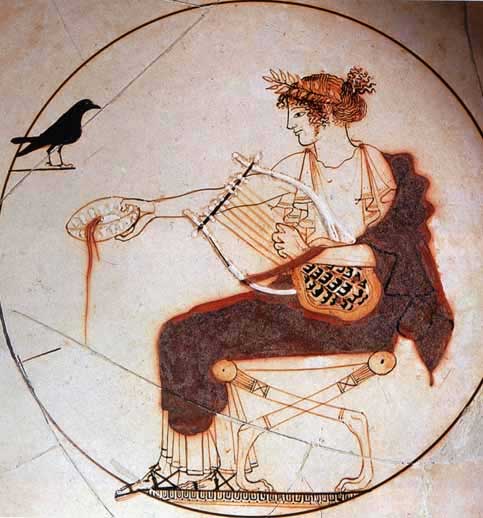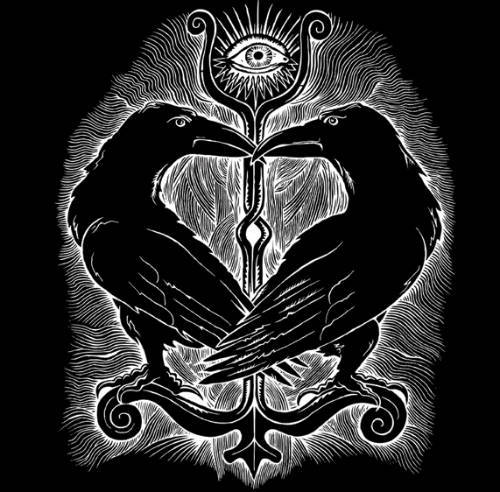Today I have been led to do a little exploration of the myths behind the Raven (or Crow, obviously). I have come to see the Raven as the polar opposite of the Swan. They are the two sides of the same coin, dealing both with life and death. The Swan represents the ascent into heaven, the rebirth of the dead, whereas the Raven is the opposite journey, that of heaven down to Earth, or of Earth down to Hades.
In Greek mythology, the Raven was an assistant to Apollo, the Sun God. Apollo was also the god of prophecy, and thus the Raven is associated to prophecy, that is, to the future. There are two versions of what happened to the Crow. In the first, he discovers that Apollo's mistress was cheating on him, and tells the Sun God. Apollo, however, is not happy, and accuses him of being a tattler. He then turns the Crow from silver (that is, a being where black and white are balanced) into black, and sends him into Hades. We have here, then, a story clearly associating the Raven to death, to the fall. The androgyne is now split.
In the second version of the story, the Raven is sent for water with a cup. He then loiters at a fig tree until the fruits are ripe (or, otherwise, eats the figs). Since Apollo would be mad about his delay, he carries it a water snake, or Hydra, and uses it as an excuse. The god doesn't buy it, though, and thus casts the Raven, the Cup (Cratera) and the Hydra into the sky. He punishes the crow by making him eternally thirsty, tantalisingly close to the water in the Cup, which is protected by the Hydra. So once again, while the Crow does technically go upwards, towards the sky, it is still a fall, for he is punished and eternally condemned (ergo, he goes to Hades, in a way).
 |
| Notice the lyre... |
It is also interesting to look at the Crow's role in North American mythology. According to some beliefs, the Raven is the creator of the world. The story goes that the Raven got bored, so he took a stone and flew with it in his beak. He got bored, though, also of carrying the stone, so he dropped it, and it became the land where humans would live. Notice how here we also have a fall, this time down to Earth.
There is also the idea of the Raven as a trickster (curiously, in Norse mythology the Raven is associated to Odin rather than to Loki). In this myth, the Raven, once again bored, decides to free some creatures, men, from a clam (I don't think I need to explain the symbolism in that one). He sees, though, that they are scared and timid, and decides to return them to the clam, before actually deciding to search for the women, who were found in a chiton (a marine mollusk). The ancestral Raven, therefore, understands the dual nature of the universe.
We seem to come upon a cycle that would go somewhat like this: Raven -> Human -> Swan. The fall from heaven and the subsequent return. There is more:
In one common North American story, Raven plays a vain and regretful Chief in a moral tale somewhat analogous to The Little Boy who Cried Wolf.
As told by the Ktunaxa (Kutenai), the people tried to convince Chief Raven that everyone should get two lives. But Raven (also the bird/manitou Raven) selfishly preferred that people and animals only get one life. This is because Raven is known to like eating the eyes of carrion. As Raven was chief and had spoken, the decision was accepted.
The people were upset, however, and decided to make Raven regret his decision. Raven's son was killed in an arranged arrow target-practice mishap. A tree was felled that struck and killed his daughter.
When this happened, Raven tried in vain to reverse his decision so that everybody would get two lives. But he was reminded, "You are the chief, and you've already spoken".
Yet again the fall from two to one. The Raven thusly interrupts the duality, which leads to his (our) fall down to Earth, or even to Hell. In the Talmud, the Crow is one of the animals who decide to copulate during the Flood, and is thus punished. The duality of the Crow is broken, and he falls. Remember that the Raven is considered to be an unclear animal, that is, impure (incomplete, or imperfect)
It is interesting to come back once again to the Knights of the Zodiac. In it, the Crow Saint (Knight) is called Jamian (Hebrew for "the right hand of opportunity"). He kidnaps Athena, and is stopped by Seiya, the Pegasus Saint and protagonist. How does he die? He falls into a precipice. In the manga, he is defeated by none other than Ikki of Phoenix.
Returning to Norse mythology, the Raven is associated to Odin in the form of his two pet informers, Huginn ("thought") and Munnin ("memory"), who scour the world for information to bring back to Odin (don't forget Odin supplies the Gandalf, or White Wizard archetype).
So not only do we have once more the primordial Raven as a dual entity, we can make an association to the concept of humans living on Earth to learn lessons, to think and acquire memories, to learn, and thus leave the Samsara and return to Heaven once more. The poem goes (this is but one of many translations):
The whole world wide, every day,
Fly Hugin and Munin;
I worry lest Hugin should fall in flight,
Yet more I fear for Munin.
That is, it happens that one could lose the capacity to think, but it would be tragic for a soul to lose its memory. This could also be interpreted as a fear of losing the dual nature.It is also curious that the two Ravens are bestowed the gift of speech for their services.
Elsewhere:
- In Chinese mythology, the Raven is a solar symbol (Apollo). Supposedly, the three-legged Raven lives in the Sun, representing its three phases (related to the astrological Cardinal, Fixed and Mutable phases);
- In Aborigene legend, the Raven is punished (charred black) for trying to steal the fire from the Pleiades;
- To the Egyptians, the Raven represents destruction (fall);
- In Celtic lore, Ravens are associated with the Morrigan and Morgan le Fay, in addition to being tricksters. The Crow is also the favourite of the Sun gods of the region.
I shall go into a crow
with sorrow and such and a black thraw
And I shall to in the Devil's name
Until I come home again!
---
Crow, crow, crow God,
Send Thee a black thraw
I was a crow just now
But I shall be
in a woman's likeness even now
Crow, crow, crow God,
Send Thee a black thraw!Ravens are, as mentioned before, prophetic birds. The old rhyme says:
One for bad news,
Two for mirth,
Three is a wedding,
Four is a birth.
Five is for riches,
Six is a thief.
Seven, a journey,
Eight is for grief.
Nine is a secret,
Ten is for sorrow.
Eleven is for love,
Twelve - joy for tomorrow.
Twelve, just like the Zodiac, and the number of hours, and months, and so on. The first two are particularly interesting.
Well, that's it for now, but I'll be revisiting the figure of the Crow, especially as it relates to the Swan, and possibly other symbols.





No comments:
Post a Comment